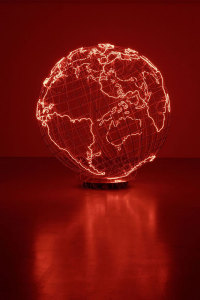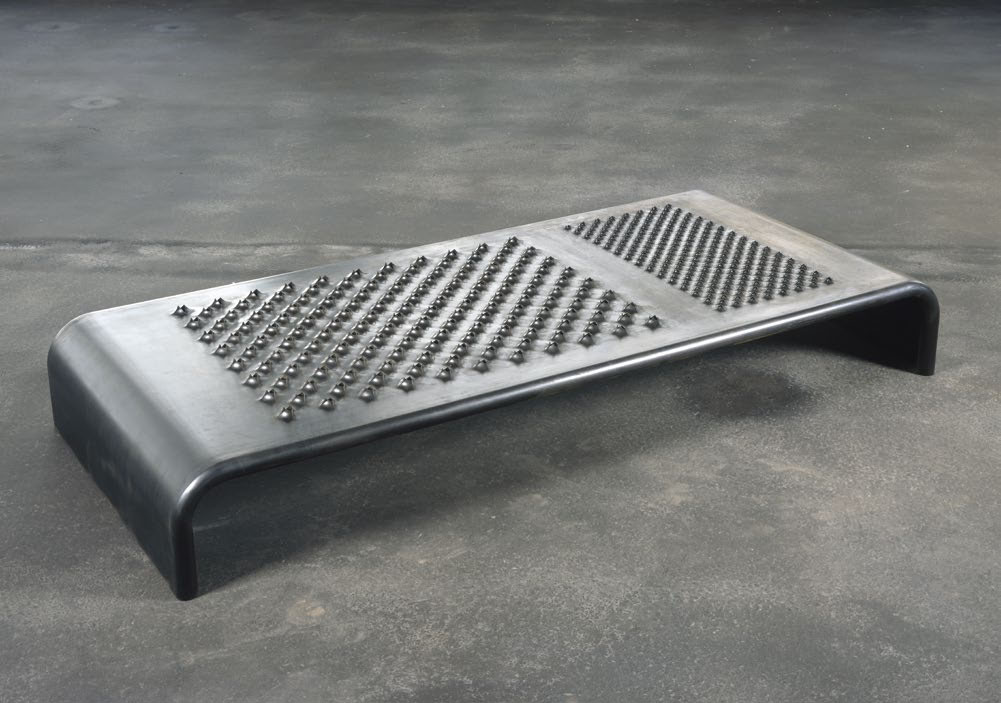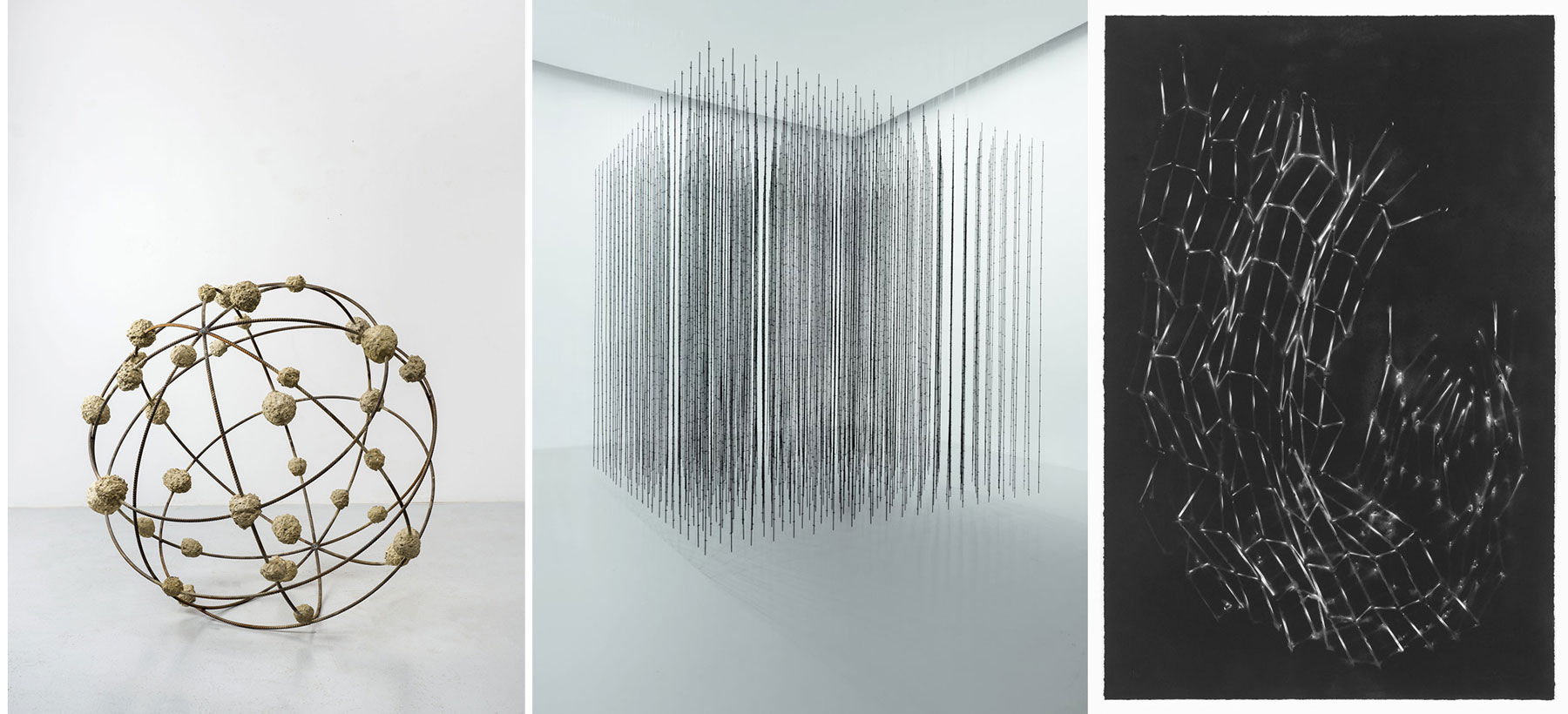ART-PRESENTATION: Mona Hatoum
 Mona Hatoum is interested in creating formally simple and reductive works that nevertheless impact viewers on an emotional and psychological level. Her work is intentionally created with paradoxical layers of meaning that produce ambiguity and ambivalence to allow several possible and contradictory readings. She often uses attractive and seductive materials to create alluring objects and installations that, on close inspection, reveal a hidden layer of threat or danger lurking underneath the surface.
Mona Hatoum is interested in creating formally simple and reductive works that nevertheless impact viewers on an emotional and psychological level. Her work is intentionally created with paradoxical layers of meaning that produce ambiguity and ambivalence to allow several possible and contradictory readings. She often uses attractive and seductive materials to create alluring objects and installations that, on close inspection, reveal a hidden layer of threat or danger lurking underneath the surface.
By Efi Michalarou
Photo: IVAM Archive

Featuring large-scale installation, sculpture and works on paper from the past two decades, the major solo exhibition of Mona Hatoum, recipient of the Julio González Prize 2020, attempts to highlight the artist’s diverse and profound works, many of which have become icons of the 21st Century. Hatoum’s practice is multi-layered and porous, offering profound physical experience with complex, nuanced meaning. While often employing seductive materials or humorous, double-edged titles in her works, their alluring, visual seduction belies darker, often threatening themes and scenarios. Mona Hatoum is well known for her large-scale installations and sculptures which challenge the formal languages of minimalism and surrealism to expose a world characterised by conflicts and contradictions. She began her career in the 1980s with performance and video works in which the body gave expression to a divided reality, besieged by political and social control. In the video “Roadworks” (1985), she documents a performance where she walked barefoot through the streets of Brixton with a pair of Doc Marten boots tied to her ankles. “Measures of Distance” (1988) is a video work comprising several layered elements. Letters written by Hatoum’s mother in Beirut to her daughter in London appear as Arabic text moving over the screen and are read aloud in English by Hatoum. The background images are slides of Hatoum’s mother in the shower, taken by the artist during a visit to Lebanon. Taped conversations in Arabic between mother and daughter, in which her mother speaks openly about her feelings, her sexuality and her husband’s objections to Hatoum’s intimate observation of her mother’s naked body are intercut with Hatoum’s voice in English reading the letters. The body has always been central to Hatoum’s work and she is known for referencing its vulnerability and resilience, as exemplified by “Corps étranger” (1994), an endoscopic journey through the interior and exterior landscape of the artist’s own body. Her installations also situate the body as subject to power or incarceration, evident in “Impenetrable” (2009), a suspended square formed of hundreds of delicate rods of suspended barbed wire, and the iconic “Light Sentence” (1992). In this work, walls of industrial wire mesh lockers and a single moving lightbulb create dramatic shadows that transform the gallery into a disorientating and unstable place. Furniture and other familiar objects feature prominently in her work, often modified and scaled up, to explore the fine line between the familiar and the uncanny. “Homebound” (2000), for example, consists of an assemblage of kitchen utensils and household furniture connected by electric wire, through which runs an audible electric current. “Grater Divide” (2002) mimics a room divider, like those used in changing rooms or hospitals. You’ll quite quickly notice, however, that this object is a 185 cm cheese grater. The piece is both comical and sinister, strangely graceful as a sculptural piece. The holes in the kitchen utensil are relatively harmless, but scaled up to these proportions they become threatening and potentially harmful. “Marble Slicer” (2002) is a giant-sized egg slicer capable of slicing through stone, suggests that transformations are possible, that there are untapped powers of sharpness everywhere in the everyday. Her deceptions on the eye can be merrily confrontational, defiant, tragic, or all of these at once. In “Mobile Home” (2005), a pulley system keeps a series of household objects – a bed- roll, table, chair, cup, plate, child’s toy, washing on a line, plastic basin, suitcase, inflatable slightly deflated see-through globe – always on the move. It’s unbearably – yes – moving. It’s a singular vision of an everyday deflating of millions of people’s worlds. It’s a vision of our triviality, our briefness, and of the ways in which all human beings are reduced and unfixed by histories and circumstances which reduce, unfix and unhome any of us. “Hot Spot III” (2009) is a metal globe, wrapped in neon tube emitting a mesmerizing glowing red light. When approaching the work, one feels a sensation of heat and hears an unfamiliar electric buzz. Emblematic of Mona Hatoum’s work, the geographical map is here presented as a statement for a world embroiled in conflict and a territory in flux. For “Orbital II” (2018), Mona Hatoum uses materials borrowed from the construction industry: the curved steel rebar forms a globe punctuated by clumps of concrete that also look like orbiting planets. Hatoum’s work highlights the condition of displacement, shared by many in the modern era. “Present Tense” (1996) is made from 2,200 cubes of traditional olive oil soap from Nablus, a city north of Jerusalem. Lines of tiny red glass beads pushed into the surface depict the map of the 1993 Oslo Peace Accord between Israel and the Palestinian Authorities. In the recent installation “Twelve Windows” (2012-13), comprising twelve pieces of embroidery made by Palestinian women living in refugee camps in Lebanon, embroidery becomes an act of resistance. Organised and produced by Inaash, a Lebanese NGO, these delicately embroidered ‘windows’ are suspended on crisscrossing steel cables, each one representing key Palestinian regions through their unique motifs, stitches, colors and patterns. In a serial approach, Mona Hatoum repeats the motif in drawings on parchment paper entitled “Drawing Heat”. She produces a freehand drawing with a hot metal rod creating a form by removing material from the surface of the paper. For “Untitled (bed springs) I” and “Untitled (bed springs) II” (both 2018), an organic grid shape emerges. These lithographs were produced by using bedsprings, removed from the frame and applied directly to the stone, creating a variation on the classical form of the regular, geometric grid – which then seems to evaporate and evoke a possible liberation.
Photo: Mona Hatoum, Paravent, 2008. © Mona Hatoum. Courtesy Galerie Max Hetzler, Berlin/Paris (Photo: def image)
Info: Institut Valencià d’Art Modern (IVAM), Guillem de Castro 118, Valencia, Duration: 16/4-12/9/2021, Days & Hours: Tue-Thu & Sat 10:00-19:00, Fri 10:00-21:00, www.ivam.es



Center: Mona Hatoum, Impenetrable, 2009. Installation view at Mathaf: Arab Museum of Modern Art, Doha. © Mona Hatoum. Courtesy Mathaf: Arab Museum of Modern Art (Photo: Markus Elblaus)
Right: Mona Hatoum, Untitled (bed springs) I, 2018. © Mona Hatoum. Courtesy Edition Copenhagen (Photo: Lars Gundersen)


